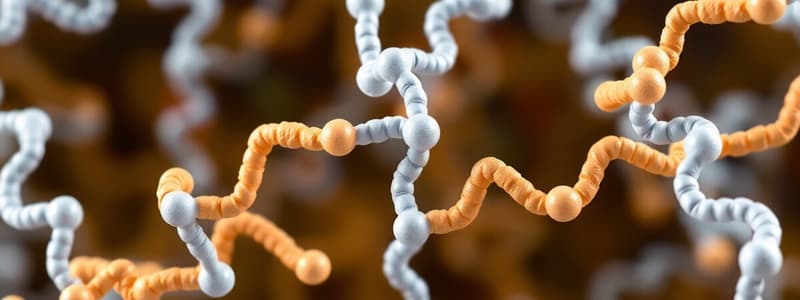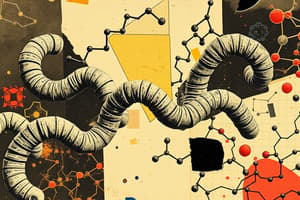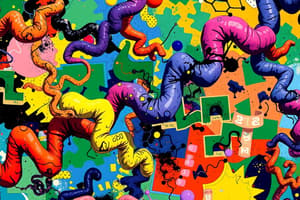Podcast
Questions and Answers
What are proteins primarily composed of?
What are proteins primarily composed of?
- Amino acids (correct)
- Nucleotides
- Fatty acids
- Monosaccharides
Which of the following accurately describes the stability of proteins?
Which of the following accurately describes the stability of proteins?
- Proteins are marginally stable, achieving stability within narrow ranges. (correct)
- Proteins achieve stability within broad ranges of temperature and solvent conditions.
- Proteins are unstable and denature rapidly in all conditions.
- Proteins are highly stable in extreme temperatures and pH levels.
What can lead to the denaturation of a protein?
What can lead to the denaturation of a protein?
- Increasing the amino acid sequence length
- Formation of peptide bonds between amino acids
- Changes in temperature, pH, and exposure to chemicals (correct)
- Addition of carbohydrates to the protein structure
How do the structures of proteins affect their functions?
How do the structures of proteins affect their functions?
Which statement correctly reflects the types of proteins mentioned?
Which statement correctly reflects the types of proteins mentioned?
What is a significant characteristic of proteins regarding their diversity?
What is a significant characteristic of proteins regarding their diversity?
How does the amino acid sequence relate to proteins?
How does the amino acid sequence relate to proteins?
Which shape is specifically mentioned as a form that proteins may take?
Which shape is specifically mentioned as a form that proteins may take?
What can cause permanent changes to a protein's shape?
What can cause permanent changes to a protein's shape?
What defines the marginal stability of proteins?
What defines the marginal stability of proteins?
Flashcards
What are proteins?
What are proteins?
Proteins are large molecules composed of long chains of amino acids linked together in a specific sequence.
Why do proteins have different functions?
Why do proteins have different functions?
Proteins can have many different shapes and functions due to their unique amino acid sequences.
What determines protein structure?
What determines protein structure?
The specific order of amino acids in a protein chain determines its three-dimensional structure.
What happens when a protein is denatured?
What happens when a protein is denatured?
Signup and view all the flashcards
What are some key functions of proteins in living organisms?
What are some key functions of proteins in living organisms?
Signup and view all the flashcards
Why is protein shape so important?
Why is protein shape so important?
Signup and view all the flashcards
How is protein structure related to its amino acid sequence?
How is protein structure related to its amino acid sequence?
Signup and view all the flashcards
What is protein denaturation?
What is protein denaturation?
Signup and view all the flashcards
What are the different types of proteins and their functions?
What are the different types of proteins and their functions?
Signup and view all the flashcards
Why are proteins so essential to life?
Why are proteins so essential to life?
Signup and view all the flashcards
Study Notes
Protein Structure and Function
- Proteins are polymers of amino acids arranged in a linear sequence.
- They are one of the most abundant organic molecules in living systems and have the most diverse range of functions of all macromolecules.
- Functions include structural, regulatory, contractile, protective, transport, storage, membrane-related, toxic, and enzymatic roles.
- Each cell in a living system may contain thousands of proteins, each with a unique function. Their structures, like their functions, vary greatly.
- Protein structures and molecular weights vary, critical to its function, and this shape is maintained by many different types of chemical bonds.
- Some proteins are globular in shape, while others are fibrous in nature.
- Exposure to chemicals, changes in temperature, and pH may lead to permanent changes in the shape of the protein, causing denaturation.
- Proteins are marginally stable, achieving stability within narrow ranges of temperature and solvent conditions.
- Protein structure is dictated by the amino acid sequence.
- All proteins are made up of different arrangements of the 20 alpha amino acids.
- Every cell has many proteins, each with unique roles.
- Protein shapes can be globular or fibrous.
- Denaturation can occur with chemical exposure, temperature or pH changes, causing permanent shape alterations.
- Protein stability is sensitive to temperature and solvent conditions.
- Protein structure directly correlates with their amino acid sequence.
- Proteins are made of a variety of amino acid arrangements.
Studying That Suits You
Use AI to generate personalized quizzes and flashcards to suit your learning preferences.





